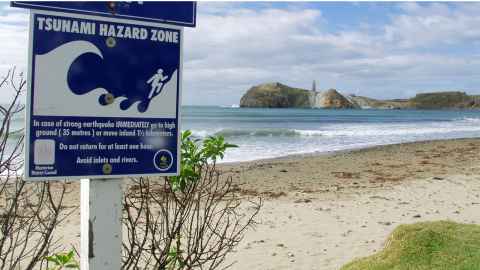Would you have been ready for a tsunami?
10 March 2021
Opinion: In an emergency we can't wait for civil defence to come to the rescue. It's important to have your own emergency plans in place, writes Carol Mutch.

On Friday March 5, a swarm of earthquakes jolted New Zealand. The first one was off East Cape in the very early hours of the morning. Many people along the coastline remembered the tsunami drill message: “If it’s long or strong get gone” and headed uphill or inland. That jolt was followed by further aftershocks and, a little later, an even larger earthquake centred near the Kermadec Islands, 900 kilometres north.
It must have been frightening and confusing for those who left their homes that morning - and the day continued with further tsunami warnings from the Kermadec quakes. Yet, despite criticism that some tsunami sirens did not work or phone messages arrived too late, the overall response was calm and sensible. When the all-clear was given to return to homes or workplaces, the new Minister for Emergency Management, Kiri Allan, among others, praised the responses of the affected individuals, families and communities.
I have been researching disaster response and recovery for the last decade, both in New Zealand and around the Asia-Pacific. One of the big lessons from disaster research is that you never know when the next crisis is coming but it is coming – something we are still learning first-hand from the Covid-19 pandemic. Every unexpected event offers the opportunity to pause and consolidate what we have learned or are still learning. I am going to pick up on several points I noted while watching the events of Friday unfold.
My first point is that it appears there is still some confusion around the role of Civil Defence. In my research on the Canterbury earthquakes, I heard stories of people remaining in their homes, waiting for Civil Defence to "come and rescue them" as if it was a sleeping army that could be awoken at short notice. Similarly, on Friday, I heard people mention "waiting for Civil Defence to tell them what to".
The idea behind civil defence is that it is a network of local authorities, agencies and volunteers who support local communities to prepare for, respond to and recover from emergencies. When an event happens, it takes time to get the accurate information needed to activate whatever and whoever is necessary. Depending on the emergency, location or lead agency, the response might vary.
It is important for communities, therefore, to realise they are part of local civil defence. It helps to be aware of local hazards and risks, and to plan, prepare and practise for possible emergencies. The research tells us that you are more likely to be rescued or evacuated, in the first instance, by a family member, co-worker, manager or passer-by than a formal first responder.
The communities on the East Coast and in Northland knew this. They had already practised tsunami drills. On Friday, they followed natural warnings, in their case, the strength of the quake, and put their drills and plans into action. We heard of local kaumatua, fire brigades, business owners and school principals swinging into action to get people to safety - and then keeping them calm and cared for.
This leads me to my next point. The research shows us that communities that that are well-networked, where people know each other, know what resources are available in their area and can mobilise quickly are not only likely to respond more effectively but are also better prepared to deal with on-going recovery. And, we also know that recovery, whether from physical loss and damage or emotional trauma and stress, can take longer than anticipated.
My final point is that while we might feel that we got off lightly on Friday, we need to see what happened as coming on top of many other stresses that individuals, families and communities are dealing with. There are terms, such as ‘secondary stressors’ and ‘cascading trauma’ that are used to talk about the cumulative effects of multiple events. Whether it is the impact of Covid-19, the memory of prior trauma, the anxiety of the unknown, or the fear of loss, we need to understand that people process things differently and they need our kindness and compassion. Be willing to listen rather than to judge.
We don’t know when the next event will occur but we can use Friday’s reminder to be better prepared. Have you checked your emergency kit? Have you updated your emergency contact list? Have you familiarised yourself with the risks and hazards in your region? Have you practised drills or escape routes with your family or at your workplace? Take the opportunity to do this now before the next unexpected happening happens.
Professor Carol Mutch is from the Faculty of Education and Social Work. She is also the Education Commissioner for the New Zealand National Commission for UNESCO.
This article reflects the opinion of the author and not necessarily the views of the University of Auckland.
Used with permission from Newsroom Would you have been ready for a tsunami? 10 March 2021.
Media queries
Alison Sims | Research Communications Editor
DDI 09 923 4953
Mob 021 249 0089
Email alison.sims@auckland.ac.nz